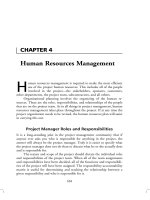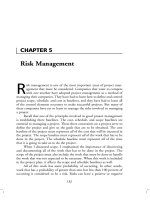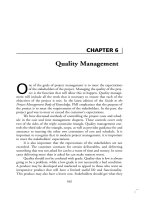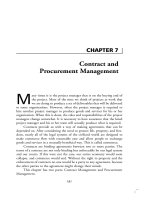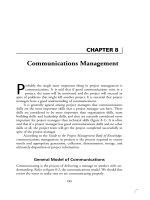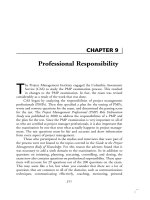Tài liệu Project Management Professional-Chapter 16a (Question) doc
Bạn đang xem bản rút gọn của tài liệu. Xem và tải ngay bản đầy đủ của tài liệu tại đây (94 KB, 10 trang )
QUALITY MANAGEMENT
1. The processes required to ensure that the project will satisfy the needs
for which it was undertaken include all activities of the overall manage-
ment function that determines the quality policy, objectives, and re-
sponsibilities and implements them by means such as quality planning,
quality control, quality assurance, and quality improvement, within the
quality system. This is called:
a. Quality assurance.
b. Quality control.
c. Quality planning.
d. Quality management.
2. Decisions as to the types of projects that should be accomplished and
strategic plans as to the quality of the projects that is required should
be the decision of which of the following?
a. Project manager
b. Procurement manager
c. Upper management
d. Stakeholders
3. According to Deming and Juran most of the quality problems that exist
are due to a defect or failure in processes that are controlled by:
a. The project manager.
b. The procurement manager.
c. Upper management.
d. Stakeholders.
4. A project manager is managing a large project and must consider the
application of a quality management plan. One of the critical factors in
such a plan is the cost of implementing the plan. The project manager
should:
a. Invoice the client for all quality improvements.
b. Implement the highest quality possible regardless of cost.
287
288 Preparing for the Project Management Professional Certification Exam
c. Implement quality improvements as long as the benefits outweigh
the costs.
d. Rely on upper management to determine the quality budget.
5. A project manager has discovered a problem and is trying to determine
the cause. The process whereby he identifies the variables that have the
most influence on the project by holding all the variables constant and
changing one at a time is called:
a. Product correlation.
b. Design of an experiment.
c. System integration.
d. Output processing.
6. A control chart is being used to control a manufacturing process. As
part of the control a sample of five parts is taken from the manufactur-
ing process each hour of operation. Each of the five parts is measured
and the dimension is recorded on the work sheet. The difference be-
tween the highest and lowest measured dimension of the five parts is
plotted on the control chart. This is called which of the following
values?
a. R
b. R bar
c. X
d. X bar
7. The totality of characteristics of an entity that bear on its ability to
satisfy stated or implied needs is the definition for:
a. Modern quality management.
b. Quality assurance.
c. Quality.
d. Quality control.
8. A large project is being worked on by a large company. The client is
interested in knowing how the company will be able to meet the quality
needs of the project. In order to satisfy this request of the client the
project manager arranges a meeting between the client and the:
9618$$ CH16 09-06-02 15:00:40 PS
289Quality Management
a. General manager.
b. Quality control manager.
c. Quality assurance manager.
d. Chief designer.
9. One of the fundamental tenets of quality management is that quality:
a. Must exceed customer expectations.
b. Is planned in and not inspected in.
c. Will increase cost.
d. Costs must all be passed onto the customer.
10. A category or rank given to products that have the same functional use
but different technical characteristics is called the product’s:
a. Quality.
b. Functional characteristics.
c. Grade.
d. Technical characteristics.
11. The quality manager of a company wishes to analyze the data that is
coming to him in the form of a list of defects that have occurred in the
shipping department. The report comes with defects listed chronologi-
cally as they occurred, the cost of the repair necessary to correct each
defect, the person involved, and a description of the defect. The man-
ager would like to determine which of the defects should be corrected
first according to the frequency of the defect occurring. He should use
which of the following quality tools?
a. Cause and effect diagram
b. Sampling inspection
c. Pareto diagram
d. Quality critical path
12. A project manager from the quality control area is trying to categorize
the number of mistakes that are made in the area that paints the right
front fender of the Mercedes 560 SL. He lists all the possible defects on
a sheet of paper and asks the inspector to make a mark each time one
of the listed defects is found. This is an example of using which of the
following quality tools?
9618$$ CH16 09-06-02 15:00:40 PS
290 Preparing for the Project Management Professional Certification Exam
a. Scatter diagram
b. Statistical measurements
c. Check sheet
d. Random sampling
13. The project management team should be aware that modern quality
management complements modern project management. For example,
both disciplines recognize the importance of:
a. Completion in the shortest possible time frame.
b. Making a maximum profit.
c. Having lower cost than a competitor.
d. Customer satisfaction.
14. In a manufacturing process that is being controlled by control charts
there are variables occurring that will affect the process output. Varia-
tions in the process that are considered to be normal process variables
are called:
a. Common causes.
b. Uncommon causes.
c. Special causes.
d. Random causes.
15. Work results, quality checklists, operational definitions, and the man-
agement plan are:
a. Inputs to quality control.
b. Outputs from quality control.
c. Inputs to quality assurance.
d. Outputs from quality assurance.
16. A control chart is being used to control a manufacturing process. As
part of the control a sample of five parts is taken from the manufactur-
ing process each hour of operation. Each of the five parts is measured,
and the dimension is recorded on the work sheet. The average of the
five parts is plotted on the control chart. This is called which of the
following values?
a. X
b. X bar
9618$$ CH16 09-06-02 15:00:41 PS
291Quality Management
c. Sample average
d. Control average
17. A project manager for the quality department is trying to solve a prob-
lem with a machine that makes die cast aluminum parts that are used in
automobiles. These parts are frequently made with defects. The project
manager has decided to hold a meeting to discuss the process of making
the parts. He creates a diagram that has branches that show the possible
causes of the problems. Each of the branches breaks the cause down
into more and more detail of the causes. This diagram is called a:
a. Pareto diagram.
b. Fishtank diagram.
c. Cause and effect diagram.
d. Scatter diagram.
18. As the manager of the production department where electrical circuits
are being made you observe the inspection station where the completed
printed circuit assemblies are being inspected. In this operation the in-
spector takes the printed circuit assembly and puts it into a fixture. The
fixture is part of a testing machine that has three digital readouts. The
inspector records the readings on the three digital readouts on his in-
spection report. This is an example of:
a. Attribute inspection.
b. Variable inspection.
c. Sampling inspection.
d. Process control.
19. One of the important advantages of using control charts in managing a
production operation is that the control chart tells you when to take
corrective action on the process being controlled. Another important
result of using control charts is:
a. The control chart identifies the special causes.
b. The control chart tells you when you should not take corrective
action.
c. The control chart shows how much the defects are costing.
d. The control chart shows who is responsible for the defects.
9618$$ CH16 09-06-02 15:00:42 PS
292 Preparing for the Project Management Professional Certification Exam
20. According to the ideas behind modern quality management, quality
improvements should be made:
a. In large steps through detailed study of problems and then imple-
mented as comprehensive solutions when they are funded.
b. In small incremental steps.
c. By assignment of permanent quality improvement teams.
d. By hiring ISO certification consultants to point out quality deficient
areas.
21. The Japanese developed a method of modern quality management that
relies on continuing small improvements involving everyone from the
top management to the lowest level worker in the organization. This is
called:
a. Kamban.
b. Kaizen.
c. PDCA.
d. Deming cycle.
22. The primary benefits of meeting quality requirements are:
a. Cost and delays are reduced, production improves, cost to customer
goes up, and profits go up.
b. Cost and delays are reduced, production improves, market share
increases, and profits go up.
c. Cost and delays are reduced, capital expenditures go down, market
share increases, and profits go up.
d. Cost and delays are reduced, production improves, market share
increases, and profits are maintained.
23. When the quality management discipline is implemented, the benefits
to costs ratio should at least be:
a. Unable to be evaluated.
b. Less than one.
c. Of little importance.
d. Greater than one.
24. The quality management plan provides input to
and
addresses quality control, quality assurance, and quality improvement.
9618$$ CH16 09-06-02 15:00:42 PS
TEAMFLY
Team-Fly
®
293Quality Management
a. The overall project plan
b. The WBS
c. The project scope
d. External stakeholders
25. Project quality assurance:
a. Includes policing the conformance of the project team to specs.
b. Provides the project team and stakeholders with standards, by which
the project performance is measured.
c. Is a managerial process that defines the organization, design, re-
sources, and objectives of quality management.
d. Provides confidence that the project will satisfy relevant quality stan-
dards.
26. The ISO 9000: 2000 standard is used to:
a. Formalize the tools of quality management.
b. Set international standards for quality conformance in organizations.
c. Set USA national standards for quality conformance in organizations.
d. Develop standards of excellence for manufacturing facilities.
27. What does ‘‘cost of acceptance’’ mean?
a. The cost of establishing and maintaining the quality function
b. The life cycle cost of the project
c. The cost of inspection and reinspection, quality assurance, quality
management, and quality planning
d. The cost of meeting project objectives
28. A control chart controls a manufacturing process. Measurements are
taken while the process is operating one time each hour. At each hour
five sample parts are measured, and the results are recorded and plotted
on a control chart. During the last five hours the following data was
observed for X bar and R. The upper control limit for X bar values is
142 and the lower control limit is 102. The value on the control chart
for X bar is 122 and the value for R bar is 3. What can be said about
this process?
9618$$ CH16 09-06-02 15:00:42 PS
294 Preparing for the Project Management Professional Certification Exam
9
A.M.
10
A.M.
11
A.M.
12
A.M.
1
P.M.
X bar 125 126 127 128 129
R 21423
a. The process is not in control and should be adjusted.
b. The process is in control and should not be adjusted.
c. The value of R is too high at 11 ..
d. The value for X bar is outside the control limits.
29. The diagram that ranks defects in the order of frequency of occurrence
and shows the number of defects and the cumulative percentage from
the greatest number of defects to the least number of defects is called a:
a. Bar chart.
b. Critical path.
c. Pie chart.
d. Pareto diagram.
30. Employees of a company were measured on the amount of scrap that
they produced over a period of time. The number of hours of training
that they had was also measured. When these results were plotted on a
scatter diagram, they were found to be negatively correlated. This means
that:
a. Scrap increased as training hours increased.
b. Scrap decreased as training hours increased.
c. Scrap increased as training hours decreased.
d. Scrap decreased as training hours decreased.
It was decided to set up a process to control the output of a machine that
was manufacturing buttons. The following measurements of the diameter of
the button were made. Each hour a sample of four buttons was taken. The
measurement shown in the table is the measured ten-thousandths of an inch
in excess of 1.000 inches. The engineering tolerance on this part is 1.000
ע.005. The following table of data values was collected:
Hour Item 1 Item 2 Item 3 Item 4
1 10201731
22243מ12 40
9618$$ CH16 09-06-02 15:00:43 PS
295Quality Management
3 16293633
40544מ24 33
510מ44 33 42
60833מ44 מ23
7252750מ12
8 33412210
948מ33 31 04
10 מ25 28 12 22
Based on the information in the table above answer questions 31, 32, and 33.
31. What is the value of X bar for day number 7?
a. .00900 inches
b. 22.5 inches
c. 90 inches
d. .00225 inches
32. What is the value for R on day 10?
a. .0037 inches
b. .0053 inches
c. 37 inches
d. 53 inches
33. What is the value for R bar?
a. .00551 inches
b. 55.1 inches
c. .010 inches
d. 10 inches
34. In acceptance sampling the ideal operating characteristic curve would:
a. Reject all lots that were above the AQL.
b. Accept all lots that were above the AQL.
c. Have buyer’s risk below the AQL.
d. Have seller’s risk below the AQL.
35. A company uses sampling inspection to inspect parts that are sent to
their customers. If a lot of parts is rejected from sampling inspection, it
is inspected 100% and the rejected parts are sent back to the manufac-
9618$$ CH16 09-06-02 15:00:43 PS
296 Preparing for the Project Management Professional Certification Exam
turing department for rework or scrap. What happens to the overall
outgoing quality level as the number of defective parts increases?
a. The overall outgoing quality level decreases at first and then increases.
b. The overall outgoing quality level increases at first and then decreases.
c. The overall outgoing quality level decreases.
d. The overall outgoing quality level increases.
36. ISO standards are reviewed and reissued every:
a. Ten years.
b. One year.
c. Two years.
d. Five years.
37. In the Shewhart and Deming cycle, the letters P D C A stand for:
a. Purchase, deliver, cost, and acquisition.
b. Prevent defects caused by anyone.
c. Plan, do, check, and act.
d. Please don’t cause accidents.
38. The Deming cycle is usually represented by:
a. PDCA.
b. ABCD.
c. QFAP.
d. CDPA.
39. Attribute inspection is performed on a lot of motor shafts. The lot of
parts is rejected. The parts are supposed to have a diameter of 2 inches
and have an engineering tolerance of ע.015. What is the average di-
mension of the parts?
a. Greater than 2.015 or less than 1.985
b. Greater than 0.000
c. Parts should not be rejected.
d. The inspector should be fired for not writing a better report.
9618$$ CH16 09-06-02 15:00:44 PS



